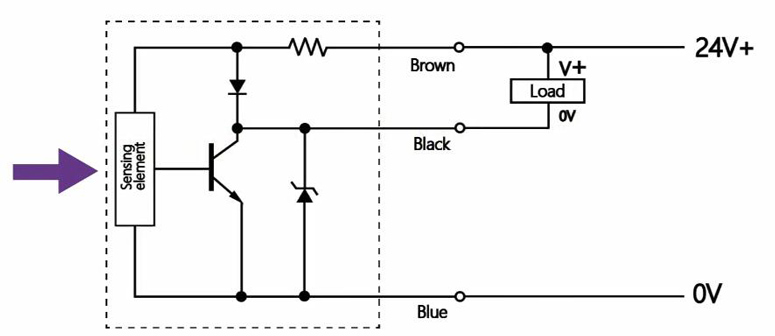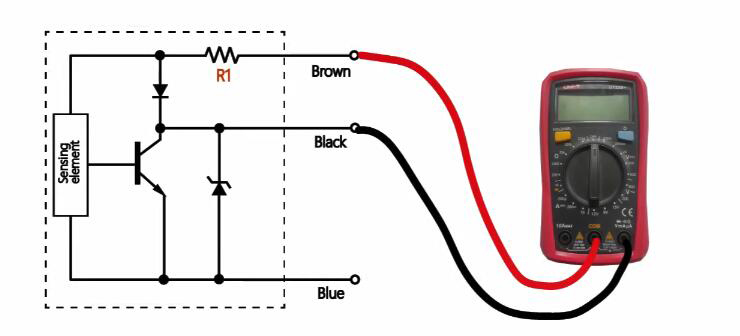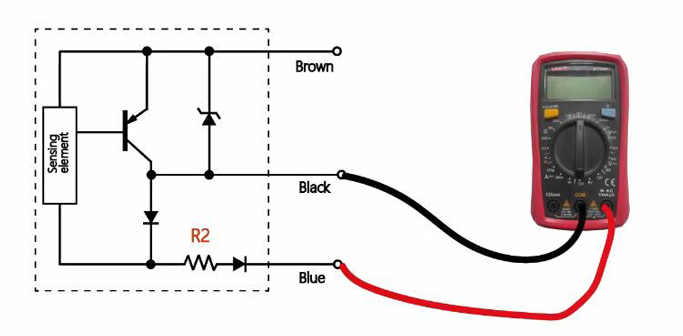Difference Between Proximity Switch NPN and PNP
A proximity switch is a position switch that can be operated without direct mechanical contact with moving parts. When the object is approaching and the sensing surface of the switch is at the action distance, the switch can be actuated without mechanical contact and any pressure to drive the DC electrical appliance or provide control instructions to the computer (plc) device. ATO proximity switch is a non-contact switch. It not only has the characteristics of a limit switch and microswitch but also has sensing performance.
We will occasionally encounter a broken proximity switch without a nameplate. Losing the nameplate is troublesome. If you want to replace it, you need to know whether it is NPN or PNP.
Analysis of internal circuit of NPN & PNP proximity switch
The picture below is of NPN type. When the proximity switch is triggered, this is the current trend of the NPN proximity switch. The black output terminal of the proximity switch is connected to the 0V of the load. When the PNP proximity switch is triggered, the current flows from the black output terminal to the V+ of the load.

Is it possible to measure its polarity with a multimeter? We need to know that the transistor is the main logic component of the proximity switch.
NPN type
The condition of NPN type output is Uc> Ub> Ue, and a pull-up resistor (R1) is required.
PNP type
The condition of PNP type output is Ue > Ub > Uc, and a pull-down resistor (R2) is required. The NPN or PNP type of the proximity switch is usually determined by the transistor inside the proximity switch. In principle, the polarity can be known by judging the resistance between the output terminal and the input terminal with a multimeter.
In principle, the polarity can be known by judging the resistance between the output terminal and the input terminal with a multimeter. The following picture is of the NPN type.

In principle, the polarity of the proximity switch can be determined by finding the position of the resistor R. The picture below is PNP type. NPN type needs pul-up resistor R1, PNP needs pull-down resistor R2.
 However, there are many non-linear components (crystal diodes, triodes) in the proximity switch circuit, so it is not easy to use a multimeter to measure the proximity switch to distinguish the polarity.
However, there are many non-linear components (crystal diodes, triodes) in the proximity switch circuit, so it is not easy to use a multimeter to measure the proximity switch to distinguish the polarity.
Let's do an experiment.
In the 20kΩrange, the measured resistance between the black output terminal and the brown (N+) is 11kΩ. The black output and blue (0V) are infinite. After switching to the 200kΩ gear, their resistances are 70.4kΩand 69.8kΩrespectively. This is because there are non-linear components inside, So this method is more difficult to determine the polarity of the proximity switch.
Can it be judged by measuring the polarity of the black output line?
The following data can be calculated by analyzing the circuit diagram. We can analyze the voltage speculation data in the table from the previous circuit.

After triggering, the black and blue voltages are 0V and the black and brown voltages are -24V. From the table, both NPN NO type and PNP NC type can correspond to the measurement results, so the polarity of the proximity switch cannot be judged. From the table, both NPN NO type and PNP NC type can correspond to the measurement results, so the polarity of the proximity switch Cannot be judged.
We changed a proximity switch with a different polarity. When it is not triggered, the measured black and blue voltages are 24V+ and the voltage between black and brown is 0V. After triggering, the black and blue voltages are 0V (low level), and the black and brown voltages are -23.5V. This result is similar to the result of the previous test. Both NPN NO type and PNP NC type can correspond.
Can it be judged by measuring the polarity of the black output line? No, because the proximity switch has a NO type and an NC type, which will increase the false positive rate. So, we only need to remember the output to know the polarity of the proximity switch.
If you want to know more details, please check:

